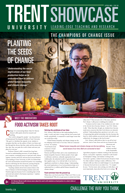Trent University Materials Science Ph.D. student Theresa Stotesbury will receive a $150,000 scholarship over three years, as a recipient of Canada’s most prestigious scholarship for doctoral students – the Vanier Canada Graduate Scholarship, announced today in Quebec City by the Honourable Greg Rickford, minister of State (Science and Technology).
“I consider it a great honour to carry this title,” said Ms. Stotesbury. “A whole new level of research has opened up for me and I appreciate the support of faculty and the top facilities I am gaining access to.” Ms. Stotesbury chose to study forensic science because it is a highly analytical discipline. “I have always loved problem solving and critical thinking,” she said. “It is also a newly developing field and has many research opportunities to participate in.”
An emerging scientist in bloodstain pattern analysis, Ms. Stotesbury will focus her research on the creation of a synthetic blood substitute that could be used by professionals and researchers in the forensic sciences. Ms. Stotesbury is a Ph.D. candidate in the Materials Science Graduate Program. Her project involves an important partnership agreement with the Ontario Provincial Police (OPP).
Ms. Stotesbury is returning to Trent as a Forensic Science B.Sc. (Honours) alumna. She completed her M.Sc. in Forensic Science at the University of Auckland in New Zealand, where she will continue with collaboration for her ongoing research. Her supervisory team here at Trent includes Dr. Andrew Vreugdenhil, director of the Materials Science Graduate program; Dr. Paul Wilson, Canada Research Chair in DNA Profiling, Forensics and Functional Genomics; and Mike Illes, a research associate with the Materials Science Graduate program and retired Ontario Provincial Police Identification Staff Sergeant.
"I am delighted that Theresa is being recognized with the Vanier Award,” said Professor Vreugdenhil. “She is a truly outstanding student with respect to her scholarship but also for her leadership within the Trent community and beyond. I am excited about the interdisciplinary skills she brings to the program and look forward to her very bright future."
The purpose of the research is to create a synthetic blood substitute that will be very useful for research, training, and education purposes. It could be used for crime scene reconstruction, DNA analysis, and bloodstain pattern analysis.
“There is a great need for this because of health and safety concerns about using animal or human blood,” explained Ms. Stotesbury. “Transmission of blood-borne diseases and concerns for biohazard safety exist; and protecting students, employees and researchers is a priority.”
Conducting research with Professor Andrew Vreugdenhil, associate professor of Chemistry and director of the Trent Centre for Materials Research, Ms. Stotesbury is currently working in the lab to mimic the physical characteristics of red blood cells using silicon colloid chemistry.
Research with Professor Paul Wilson will involve adding synthetic DNA to the fluid to tackle its relevant biological components in forensics. The goal is for the artificial blood to behave like real blood chemically, biologically and physiologically.
Another aspect of the study involves working alongside Mike Illes at the local OPP headquarters with a high-speed video camera to look at how bloodstain patterns form, particularly to see what happens when the substance is struck by a weapon. The OPP provides bloodstain analysts on site who provide expertise and benefit from the developments in the research. A custom-built, impact-simulation machine built for the project measures at nine feet tall and is controlled by a computer. “You hit a key, and a stainless steel rod hits a pool of ‘blood’,” explains Ms. Stotesbury. “The video camera captures footage of it, and we analyze its fluid dynamics on the computer.”
Ms. Stotesbury’s relationship with the OPP began in the fourth year of her Honours B.Sc. in Forensic Science at Trent. She created a unique project at that time in collaboration with Chemistry and Forensic Science Departments and the OPP. Upon graduation, Ms. Stotesbury was awarded with the Symons Medal for high overall standing. She was also awarded the Daniel Rhan Memorial Grant which led to her presentation for the International Association of Bloodstain Pattern Analysts.
About the Vanier Scholarship
Vanier Canada scholarship recipients are selected through a rigorous, competitive process. First, potential scholars are nominated by a Canadian university. These nominations are evaluated by selection committees struck by Canada’s three research granting agencies—the Social Sciences and Humanities Research Council of Canada (SSHRC), the Natural Sciences and Engineering Research Council of Canada (NSERC), and the Canadian Institutes of Health Research (CIHR). Finally, an international, blue-ribbon selection board then ranks Vanier scholarship recipients and recommends them for funding.
Considered the most important, prestigious and sought-after scholarship for doctoral students, the Vanier is on par with such highly renowned scholarships as the Rhodes scholarships in the United Kingdom and the Fulbright scholarships in the United States.
Posted on Monday, September 23, 2013.


































